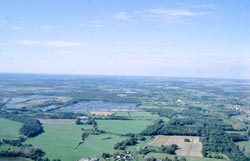Our local environment |
The Touraine countryside |
Touraine-du-Sud: This secluded region, far from the tourist honey pots, is unlike the popular image of Touraine. It is a region that keep its delights for those who take the time to stop a while. It is a region where history is to be discovered around every corner. |
Where we are |
Le
Grand-Pressigny: Le
Grand-Pressigny is also the main town in a district with communities
maintaining a deep sense of tradition : Agriculture
is still the main economic activity and provides the local gastronomic
restaurants with prime produce The tuffeau limestone farmhouses are characteristic of the region and the châteaux that dominate the region, Le Grand-Pressigny, Etableau, La Celle-Guenand, La Guerche, Ré, Paulmy and le Châtelier, are built of the same stone. It is, however, the flint embedded in the limestone that has brought fame to the district. The
district around le Grand-Pressigny is wooded and cut by several
rivers: For nature lovers, there are many country walks and cycle rides for discovering the richness of the local flora and fauna. |
The area round La Forge |
La Forge lies in a shallow valley formed by the Aigronne river that runs nearly 50 kilometres from the Etang de l'lle [near Obterre] to le Grand Pressigny, where it joins the Claise. This shallow valley has numerous mills along its length... some were corn/flour/saw mills but many others, including La Forge, were connected with the local iron industry. We think that our forge was a blast furnace turning out raw iron from the local sources of ironstone, limestone and charcoal. The wheel would have driven bellows. We have found large chunks of slag, still heavy with impure iron, on the site. In the ten kilometres between Petit & Grand Pressigny there are nine mills [none of them working mills, sadly.] |
The La Forge wilderness |
Our bigger chunk of land is a "leg of mutton" shaped wedge bordered by the river itself and the bief Additionally, we have the land round the house and barn which is where we have allocated space to 'grow our own'. The main acreage though is to be managed for wildlife. We are planting areas of willow, hazel, field maple, dogwood and spindle for coppicing. This, when done on a 5 to 10 year cycle will allow us to create an ever changing habitat. The main trees in the field are five Willows and an Alder. The alder, although previously pollarded, does not need attention at the moment. The five willows, however, were another story altogether [The Forest in the Sky]. They are now all carefully pollarded and good for another twenty or so years. Given the diameter of the main trunks they are currently around 250 years old. The continuing story of the meadow area can be found on the Art en Saule blog. |

